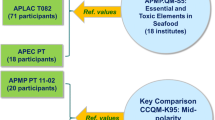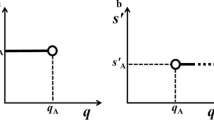Abstract
Measurement traceability is universally recognised as one of the basic prerequisites for comparability of results obtained in different laboratories and is a basic aspect of metrological sciences such as analytical chemistry. This requirement is underscored by the increasing adoption of standards and measurement quality systems, such as laboratory accreditation against ISO/IEC 17025. Testing laboratories ensure traceability of their measurement results by using appropriate reference standards for calibration of instruments and control of measurement processes. For routine work in the field of water analysis, these standards are usually commercial solutions or in-house solutions prepared from “pure” products. Therefore, laboratories should demonstrate that their use of reference standards is appropriate and sufficient, which can be done by participation in an appropriate proficiency-testing scheme. The paper reports how measurement traceability of results from field laboratories (nitrite nitrogen, nitrate nitrogen, chloride and sulphate; all in water) can be demonstrated by participation in a proficiency-testing scheme based on reference values.


Similar content being viewed by others
References
Maier EA (1996) Trends Anal Chem 15:341–348
BIPM-IEC-IFCC-ISO-IUPAC-IUPAP-OIML (1993) International vocabulary of basic and general terms in metrology. ISO, Geneva, Switzerland
CEN-CENELEC (2000) EN ISO/IEC 17025—General requirements for the competence of testing and calibration laboratories. ISO, Geneva, Switzerland
Ellison SLR, King B, Rosslein M, Salit M, Williams A (eds) (2003) Traceability in chemical measurement. Eurachem/CITAC LGC, Teddington, UK
Drolc A, Roš M (2002) Acta Chim Slov 49:409–423
Cotman M, Drolc A, Roš M (2003) Accred Qual Assur 8:156–160
Drolc A, Cotman M, Roš M (2003) Accred Qual Assur 8:138–145
Drolc A, Roš M, Cotman M (2004) Anal Bioanal Chem 378:1243–1250
International Organization for Standardization (1996) Guide 43-Proficiency testing by interlaboratory comparisons. Part 1. Development and operation of proficiency testing schemes. ISO, Geneva, Switzerland
International Laboratory Accreditation Cooperation (2000) G-13: Guidelines for requirements for the competence of providers of proficiency testing schemes. ILAC, Rhodes, NSW, Australia
van der Veen AHM et al (2001) Accred Qual Assur 6:264–268
van der Veen AHM (2001) Accred Qual Assur 6:257–263
International Organization for Standardization (1996) ISO 10304-2: Water quality—determination of dissolved anions by liquid chromatography of ions—part 2: determination of bromide, chloride, nitrate, nitrite, orthophosphate and sulphate in wastewater. ISO, Geneva, Switzerland
Eurachem (1998) The fitness for purpose of analytical methods. Eurachem LGC, Teddington, UK
NIST (2003) Certificate of Analysis SRM 3182, chloride standard anion solution. National Institute of Standards and Technology, Gaithersburg, MD
Ultra Scientific (2003) Certificate of analysis ICC–007, nitrite standard solution. Ultra Scientific, North Kingstown, RI
NIST (2003) Certificate of analysis SRM 3185, nitrate standard anion solution. National Institute of Standards and Technology, Gaithersburg, MD
NIST (2000) Certificate of analysis SRM 3181, sulphate standard anion solution. National Institute of Standards and Technology, Gaithersburg, MD
Miller JN, Miller JC (2000) Statistics and chemometrics for analytical chemistry. Prentice Hall, Harlow, UK
BIPM-IEC-IFCC-ISO-IUPAC-IUPAP-OIML (1995) Guide to the expression of uncertainty in measurement. ISO, Geneva, Switzerland
Williams A, Ellison SLR, Rosslein M (eds) (2000) Quantifying uncertainty in analytical measurement. Eurachem/CITAC LGC, Teddington, UK
International Organization for Standardization (1994) SISO 5725-2: Accuracy (trueness and precision) of measurement methods and results—part 2: basic method for the determination of repeatability and reproducibility of a standard measurement method. ISO, Geneva, Switzerland
Acknowledgements
The authors gratefully acknowledge financial support from the Ministry of Higher Education, Science and Technology of the Republic of Slovenia (Project J2-6107-0104). The National Institute of Chemistry, Ljubljana, Slovenia, Laboratory for Chemistry, Biology and Technology of Water, is holder of the national reference etalon, based on the authorisation and co-founding of the Metrological Institute of the Republic of Slovenia.
Author information
Authors and Affiliations
Corresponding author
Rights and permissions
About this article
Cite this article
Drolc, A., Cotman, M. & Roš, M. Integration of metrological principles in a proficiency-testing scheme in the field of water analysis. Anal Bioanal Chem 382, 1311–1319 (2005). https://doi.org/10.1007/s00216-005-3264-7
Received:
Revised:
Accepted:
Published:
Issue Date:
DOI: https://doi.org/10.1007/s00216-005-3264-7




